John Stafford Smith: July Composer of the Month
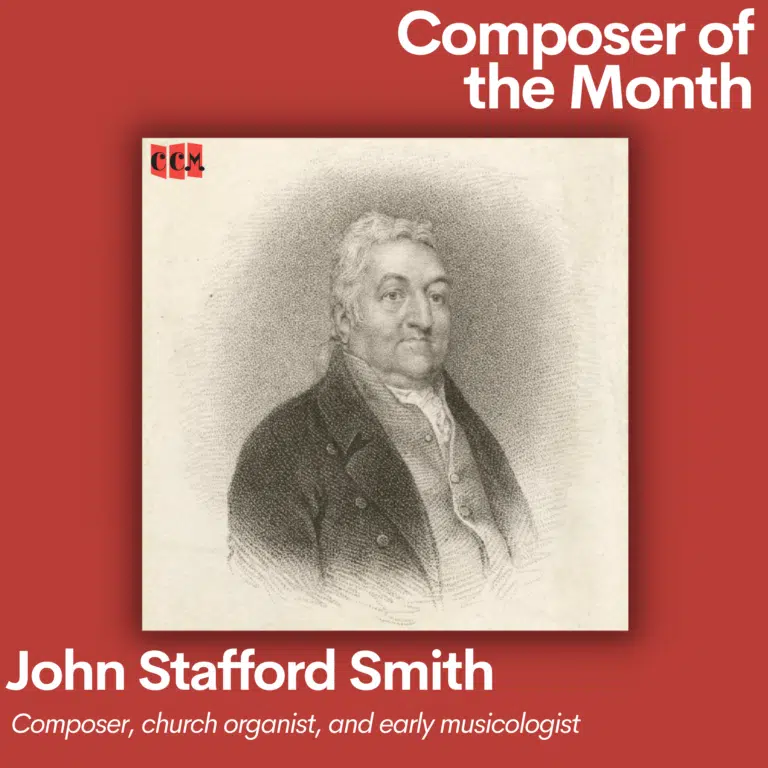
John Stafford Smith: A Brief History
John Stafford Smith was born in 1750 in Gloucester, England. From a young age, he showcased remarkable musical talent. He received comprehensive musical education and training as he studied under esteemed composers of his time. Smith’s career blossomed in London, where he emerged as a prominent musical figure in the late 18th-century. Smith created symphonies, chamber music, and choral compositions that all showcased his immense talent.The Story Behind “The Star-Spangled Banner”
“The Star-Spangled Banner” originated during the War of 1812, a conflict between the United States and the British Empire. In September 1814, poet, Francis Scott Key witnessed the British bombardment of Fort McHenry in Baltimore Harbor. He was then inspired to write a poem titled “Defence of Fort M’Henry.” Key was seeking a fitting melody for his powerful verses and turned to his friend, John Stafford Smith. Smith’s composition, “To Anacreon in Heaven,” originally written for a British men’s social club, proved to be the perfect match for Key’s patriotic lyrics. Together, they transformed the melody into what would become one of the world’s most recognizable national anthems. In 1931, “The Star-Spangled Banner” officially became the national anthem of the United States, symbolizing the nation’s unity, resilience, and indomitable spirit.National Anthems: A Brief History
National anthems hold great cultural and historical significance, offering valuable insights into a country’s identity and heritage. They serve as musical symbols of national unity, resilience, and pride. Here are a few reasons why national anthems are worth exploring:Historical Context
National anthems provide a window into a nation’s past, reflecting its struggles, triumphs, and collective memory. They embody historical events and moments of national significance, offering a deeper understanding of a country’s heritage. National anthems are sonic narratives that connect present generations to the triumphs and challenges faced by their predecessors, fostering a sense of continuity and national pride. Through the evocative power of music, national anthems become a living testament to a nation’s history, allowing us to experience the emotions and aspirations that have shaped past generations.Musical Analysis
Exploring national anthems allows us to appreciate the melodic and harmonic elements that define them. By examining their structure, tonality, and musical motifs, we gain insights into the compositional techniques employed by different composers and the cultural influences that shaped their creations. You can learn a lot about a country’s music history from their national anthem!Cultural Identity
National anthems are rich expressions of a country’s cultural identity, encompassing its traditions, values, and aspirations. By studying anthems from various nations, we can embrace the diversity of global musical heritage and foster intercultural understanding. The origin of national anthems also vary, and can provide even more information about the nation’s culture and history.Emotional Connection & Evolution
National anthems evoke a sense of pride, unity, and patriotism among citizens. By engaging with these powerful musical compositions, we can experience the emotional resonance they hold for individuals and communities. National anthems can also evoke important conversations regarding a nation’s successes and failures. The anthems can also inspire other songs and art pieces that speak to lived experiences. John Stafford Smith’s composition of “The Star-Spangled Banner” represents a pivotal moment in musical history. Through its triumphant melody and patriotic lyrics, it encapsulates the enduring spirit of a nation. National anthems, like “The Star-Spangled Banner,” are musical artifacts provide us with valuable insights into the cultural, historical, and emotional dimensions of countries around the world. Let us continue to celebrate and appreciate the composers who have left their indelible mark on our musical landscape, reminding us of the profound power that music holds in shaping our collective identity.
June Student of the Month: Orlann Louis-Marie
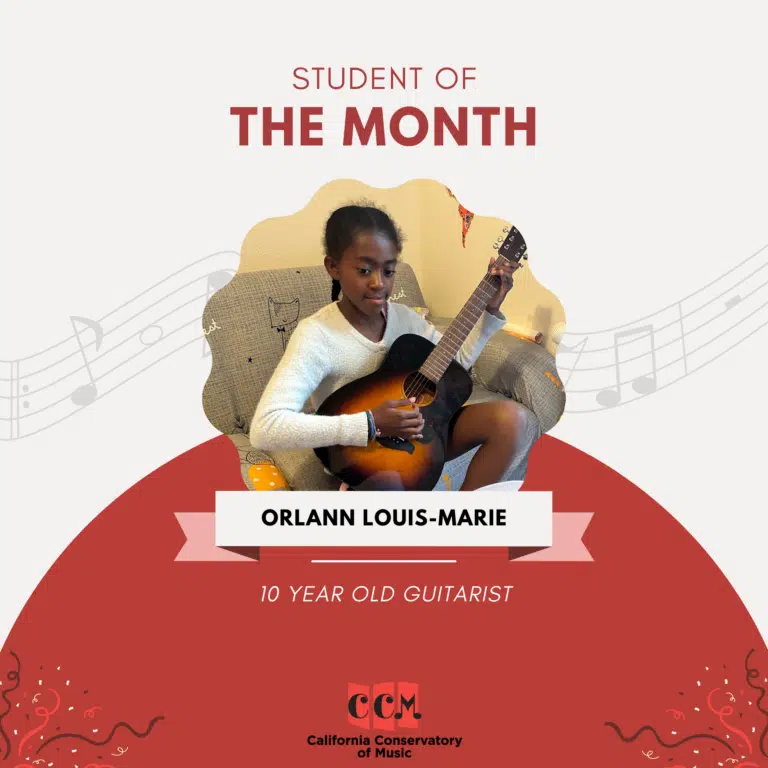
This June, we’re happy to highlight CCM guitar student, Orlann Louis-Marie, for our Student of the Month! Orlann has been taking guitar lessons at CCM for around 2 years. She currently studies at CCM’s Sunnyvale location with Teacher Rebecca. Orlann practice every day and has made amazing improvements over the years!
Student of the Month – Orlann Louis-Marie
What is your name?
Orlann Louis-Marie
How old are you?
10
Who is your teacher?
Teacher Rebecca
How long have you been taking guitar lessons?
2 years
What advice would you give to a guitar student just starting out at CCM?
Even if it is difficult, do not quit. Guitar is a good instrument.
What piece are you looking forward to learning someday?
Learning songs that have a fast tempo that others can sing along to.
What is your favorite thing about playing guitar?
It calms me down.
What is your favorite food?
Raclette. It is a traditional Swiss dish with melted cheese on potatoes.
Do you have a pet?
No
Do you play any sports or do any other activities outside of music lessons?
Soccer and climbing.
What do you want to be when you grow up?
I want to be a psychologist
What is your most memorable experience at CCM?
My first recital because I had never played in front of a crowd.
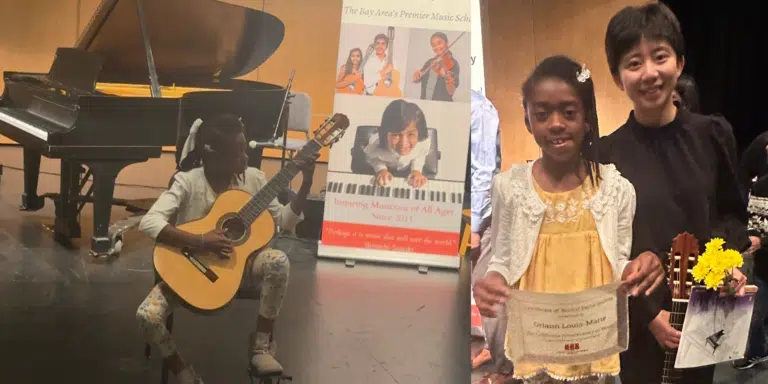
Parent Spotlight – Gwladys Louis-Marie
Regarding guitar instruction, what are you most proud of your child accomplishing?
I’ve really seen my daughter grow through her guitar playing. She has become more independent and curious in her desire to learn more.
She is learning to overcome her frustration when a piece seems difficult at first and I’m very proud of her perseverance. She’s realizing that her regularity is paying off and she is proud of herself. That makes me happy!
What advice would you give a new parent starting in the program?
Starting a musical upbringing is always exciting at the beginning but it is a journey with ups and downs. It really made us question our intentions when our schedules were full and I was the one who had to remind the practice times. Learning an instrument is at the same time, rigorous and gratifying. I think we’ve reached a point in our family where we can confidently say that music education is here to stay.
Being present by your child’s side even if you’re not a musician seems essential to me. This is a great opportunity where I get to remind my daughter to be patient and kind with herself and congratulate her on all her efforts.
Why did you decide to give your child a musical upbringing?
Music is part of our everyday life in our family. We wake up with it, commute with it and go to bed through music. I think music is a beautiful way to connect with our emotions and with others. I personally didn’t receive any solid musical training and I knew it was something I wanted to create in my children’s life. The same way I consider plurilingualism as a wonderful skill, I see music as a gift that allows my child to express herself in a worldwide language.

5 Tips for Choosing the Perfect Music Teacher
Finding a music teacher that connects well with your child is crucial for meaningful and effective music lessons. The right teacher can provide invaluable guidance, inspire creativity, and foster a love for music. However, selecting the perfect music teacher can be a daunting task. We’ve put together essential tips for finding the right music teacher for your child to enhance their learning experience and help them reach their musical goals.
Research and Credentials
When searching for a good music teacher, thorough research is key. It is important to look for teachers with solid credentials and qualifications. Consider their educational background, professional experience, and any notable achievements or accolades. A teacher with a strong musical foundation will be well-equipped to impart knowledge and nurture talent. At CCM, all of our instructors at least have their bachelor’s degree in music, but many have gone on to receive their masters as well. A lot of our teachers were even classmates together at the San Francisco Conservatory of Music! You can learn more about our teachers here.
Teaching Style and Approach
Being aware of a teacher’s style and approach is key for finding the proper fit. Some teachers may teach a classical repertoire only, while others are open to jazz, pop, and more. For this tip, it’s crucial that you reflect on your own learning preferences and goals to find a teacher whose approach resonates with you. If you would like your child to eventually learn how to compose their own music, you should make this priority clear to the teacher prior to signing up for lessons. However, a teacher who can adapt their teaching style to suit your individual needs will ensure a productive and enjoyable learning experience. At CCM, our instructors do a great job of catering the lessons to you and taking your age, level, and learning style. You can schedule a free trial lesson with one of our teachers to see what lessons would be like and to discuss your expectations and goals!
Performance Opportunities
A good music teacher should be able to support their students’ paths to success! Look for testimonials or reviews from current or past students to gauge their teaching abilities. Consider the progress their students have made, both in technical skills and overall musical development. Regular performance opportunities are important as well! Teachers should be able to prepare students for recitals, competitions, or other performances. At the California Conservatory of Music, we hold free bi-annual recitals for students. The recitals usually take place in the winter and spring and they are free for families and friends to attend! It’s always amazing to see how quickly students are progressing.
Motivating & Engaging Style
Effective communication is essential for a beneficial teacher-student relationship. An experienced music teacher will have strong interpersonal skills, practice patience, and be able to provide helpful constructive feedback in a supportive way. During an initial consultation or trial lesson, you will be able to assess their communication style and determine if it is a good fit. A teacher who can foster a positive and nurturing environment will enhance the learning journey. At CCM, teachers provide their students with fun practice challenges to keep them motivated and excited! Students can win prizes and awards such as ribbons, medals, trophies, and more.
Passion and Enthusiasm
The perfect music teacher will exude passion and enthusiasm for what they do. Their love for the art form should be evident in their teaching style and how they interact during the lessons. A passionate teacher will inspire and ignite enthusiasm in their students, making the learning process more engaging and enjoyable. Many of our teachers at CCM are working musicians and music is their passion! We have faculty recitals annually and teachers are constantly performing all around the Bay Area.
Finding a music teacher is obviously the first step to music lessons and a music education overall. Through thorough research and preparation, you will find a teacher who will meet your expectations, inspire you, and guide you on the musical journey. Remember, the right teacher can make all the difference!
Sign up for your free lesson at the California Conservatory of Music!

Caroline Shaw: June Composer of the Month

Caroline Shaw: A Rising Star in Contemporary Classical Music
Caroline Shaw is a composer, violinist, and vocalist who has quickly become one of the most exciting and innovative voices in contemporary classical music. She is the youngest person to ever win the Pulitzer Prize for Music, and the world’s leading ensembles have performed her work.
Shaw was born in Greenville, North Carolina, in 1982. She began playing the violin at the age of two, and she started composing at the age of ten. She studied violin performance at Rice University for her undergraduate degree. After graduating from Rice, she went on to earn her master’s degree in violin performance from Yale University.
While at Yale, Shaw focused more on composition. She studied with Steve Reich, and people praised her work for its originality and beauty almost immediately. In 2013, she received the Pulitzer Prize for Music for her a cappella piece “Partita for 8 Voices.” At the time, she was only 30 years old, making her the youngest person ever to win the prize.
Work as a Composer
Shaw’s music is often described as “contemporary classical” or “minimalist,” however, her work defies easy categorization or labels. She draws inspiration from a wide range of sources, including folk music, jazz, and pop. Her music is often playful, unpredictable, and deeply expressive.
Furthermore, leading ensembles such as the Kronos Quartet, the New York Philharmonic, and the Los Angeles Philharmonic have all commissioned Shaw’s works. Plus, musicians have performed her works at major festivals around the world, including the Salzburg Festival and the BBC Proms.
Musical Career
In addition to her work as a composer, Shaw is also a violinist and vocalist. She is a member of the Grammy-winning vocal ensemble, Roomful of Teeth and performed as a soloist with some of the world’s leading orchestras.
Shaw is a passionate advocate for new music. She is a co-founder of the music collective, Roomful of Teeth, and she is also a founding member of the advocacy group, New Music USA. She has a deep commitment to making new music accessible to a wider audience, and she is a tireless champion of emerging composers.
Shaw is a rising star in the world of contemporary classical music. Her work is innovative, meaningful, and deeply moving. She is a force to be reckoned with, and she is sure to continue to make waves in the years to come.
Shaw’s Compositions
One of Shaw’s most striking characteristics of her music is her use of silence. She often creates tension and suspense by juxtaposing long periods of silence with bursts of musical activity. This use of silence can be found in many of her works, including “Partita for 8 Voices” and “Narrow Sea.”
Additionally, Shaw utilizes unusual instruments and sounds in her music. In “Partita for 8 Voices,” she uses a variety of percussion instruments, including shakers, tambourines, and cowbells. She also incorporates vocal sounds, such as humming and breathing. This use of unexpected sounds helps to create a unique and otherworldly atmosphere in her music.
Shaw’s music is often described as “beautiful” and “moving.” Undeniably, she has a gift for creating music that is both intellectually stimulating and emotionally resonant. Her work is sure to continue to captivate audiences for years to come.
Conclusion
Caroline Shaw is a rising star in the world of contemporary classical music. Critics and audiences alike praise her work all around the world! Her musical endeavors and advocacy work is astonishing and setting a new precedent for musicians and composers in the classical music world.
Shaw’s impact on contemporary classical music is already huge. Her work helps to broaden the appeal of the genre, and she continues to inspire a new generation of composers. She is a true pioneer.

May Student of the Month: Elijah Yap

This May, we’re happy to spotlight CCM piano student, Elijah Yap, for our Student of the Month! Elijah has been taking piano lessons at CCM for 5 years. He currently studies at CCM’s Sunnyvale location with Teacher Dario. Elijah is always proactive with his practice! He is inquisitive in the lessons which enhances his learning experience that much more.
Student of the Month – Elijah Yap
What is your name?
My name is Elijah Rohan B. Yap.
How old are you?
I am 10 years old.
Who is your teacher?
My teacher is Teacher Dario.
How long have you been taking piano lessons?
I’ve been taking piano lessons at CCM since I was 5 years old.
What advice would you give to a piano student just starting out at CCM?
Keep practicing everyday and have fun and enjoy playing music.
What piece are you looking forward to learning someday?
I love to learn Kiss the Rain by Yiruma and more classical pieces like Canon in D by Pachelbel.
What is your favorite thing about playing piano?
My favorite thing about playing piano is that I get to play music that I like.
What is your favorite food?
My favorite food is a Filipino Escabeche that I personally call “vinegar fish soup.” It’s a fried fish cooked in a sweet and sour sauce.
Do you have a pet?
I have a Ball Python snake that I named Nagini from my favorite book and movie, Harry Potter.
Do you play any sports or do any other activities outside of music lessons?
I am not really into sports, but I sometimes play badminton and I play online games and spend time reading.
What do you want to be when you grow up?
I want to be a Cardiologist someday.
What is your most memorable experience at CCM?
My most memorable experience at CCM is participating in recitals and performing without mistakes.
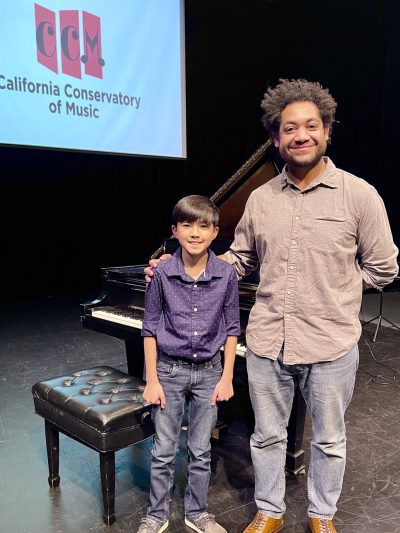
Parent Spotlight – Stella Yap
Regarding piano instruction, what are you most proud of your child accomplishing?
We are most proud of Elijah watching him play confidently at every recital in front of a lot of people and watching him work so hard and putting in a lot of effort and making sure he practices everyday and get every piece perfectly.
What advice would you give a new parent starting in the program?
Learning piano is a process that requires time. Try to be patient, and help your child to stay patient too. Encourage and motivate them to practice everyday, develop a routine but give your child the freedom to learn at their own pace, encourage them when they achieve new milestones, even if they’re just taking baby steps, and most importantly, let them have fun and make their music experience enjoyable.
Why did you decide to give your child a musical upbringing?
At a young age, Elijah already loved music and showed interest in learning how to play piano. In fact, he was the one who told us that he wanted to take piano lessons. As parents, we are here to support him and give him the opportunity to find passion and love on whatever that interests him, in this case, music. On the other hand, we know that learning music has a lot of benefits and can enhance every area of a child’s development.
Sign up for your free lesson at the California Conservatory of Music!

Music Education & Successful Public Figures
Music education is a proven crucial component in exceptional childhood development. Children who have had a music education have improved their cognitive skills, academic skills, emotional well-being, and more! Many public figures acknowledge that their early music education played a huge part in their overall success.
Music Education: A Brief Overview
Music education is the formal process of teaching music to students. This process can occur in different settings, including schools, private lessons, or community programs. It is designed to help students understand and appreciate music while developing their skills in playing musical instruments, singing, composing, or music theory.
A solid music education has several benefits for students.
- Cognitive skills: Music education is linked to enhanced memory, language, and reasoning skills. Students will improve their concentration, attention, and focus, which translates into better academic performance.
- Emotional skills: Music education also assists emotional development, such as empathy, self-esteem, and self-expression. It helps students manage stress and anxiety, as well as foster a sense of belonging and community.
- Social skills: Music education also encourages socialization and teamwork, as students often work together to create or learn music. It also promotes cultural awareness and respect for diversity.
Successful Public Figures
Over the years, many public figures have correlated their success with their early music education. These individuals are in various fields, including politics, business, science, and entertainment.
Albert Einstein
Albert Einstein was one of the most influential scientists of the 20th century. He developed the theory of relativity and made groundbreaking contributions to the field of physics. However, what many people may not know is that Einstein was an accomplished musician. He began playing the violin at the age of six and continued to play throughout his life!
Einstein once said, “If I were not a physicist, I would probably be a musician. I often think in music. I live my daydreams in music. I see my life in terms of music.” Einstein believed that music helped him to think creatively and abstractly, which he applied to his scientific work.
Steve Jobs
Steve Jobs, the co-founder of Apple Inc., is known for his innovative ideas and technological advancements. A little known fact is that Jobs was also a musician! He learned to play the guitar as a teenager and continued to play throughout his life.
Jobs believed that music helped him to think creatively and come up with new ideas. In a 1996 interview with Wired Magazine, he said, “If you want to be creative, you have to keep your mind open. And one of the ways to do that is to expose yourself to different experiences and different ways of thinking. Music was one of those things for me.”
Condoleezza Rice
Condoleezza Rice is a former United States Secretary of State and National Security Advisor. She is also an accomplished pianist and began playing at the age of three. Rice has spoken to how that music helped her develop discipline and focus, which she applied to her political career.
In an interview with NBC News, Rice said, “I think the lessons you learn from music are applicable to everything. It’s discipline. It’s focus. It’s the ability to work with others. All of those things are important in life, and certainly in leadership.”
Paul Allen
Paul Allen was a co-founder of Microsoft Corporation and one of the richest people in the world. He was also an artful musician and began playing the guitar at the age of 16. Allen felt that music helped him to think outside of the box and come up with innovative ideas, which he applied to his business ventures.
In an interview with The New York Times, Allen said, “I’ve found that playing guitar is a great way to escape from a stressful day at work. It’s a way to clear your mind and let your creativity flow. And sometimes, when you least expect it, that’s when the best ideas come.”
Yo-Yo Ma
Yo-Yo Ma is one of the most renowned cellists of our time. He began playing the cello at the age of four and has since won multiple Grammy Awards and performed in front of audiences worldwide. Ma believes that music helped him to develop discipline and perseverance, which he of course applied to his music career.
In an interview with The Guardian, Ma said, “Playing music requires a lot of hard work and dedication. It’s not something that you can just pick up and master overnight. But if you’re willing to put in the time and effort, the rewards can be amazing.”
Why Early Music Education Matters
The success of these public figures highlights the importance of early music education. Learning to play a musical instrument at a young age can have a significant impact on a child’s cognitive, emotional, and social development. Music education inspires discipline, focus, and creativity, as well as fosters a sense of belonging and community.
Moreover, music education can have long-term benefits for individuals, including improved academic performance, enhanced memory and language skills, and reduced stress and anxiety. It can also lead to a lifelong appreciation of music, which can bring joy and fulfillment to one’s life.
The correlation between public figures’ success and early music education should not be ignored. It is essential that we continue to prioritize music education in our schools and communities to ensure that all children have access to this valuable form of education.
Sign up for your free lesson at the California Conservatory of Music!

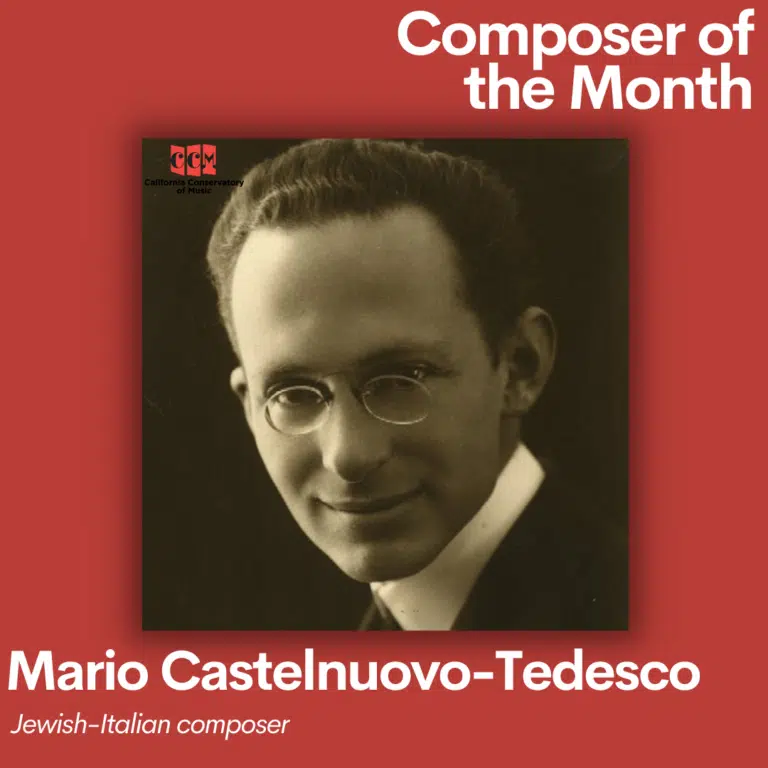
Mario Castelnuovo-Tedesco was an Italian composer and guitarist born in Florence on April 3, 1895. He was known for his prolific output of compositions, including operas, ballets, film scores, and chamber music. He was also an accomplished guitarist and wrote numerous works that have since become staples of the guitar repertoire.
Early Life and Education
Castelnuovo-Tedesco was born into a Jewish family in Florence. He showed a talent for music at a young age and began composing when he was only nine years old. His father was a successful businessman and encouraged his son’s musical pursuits. His father made sure to provide him with the best music education available at the time. Castelnuovo-Tedesco studied composition with Ildebrando Pizzetti and Carlo Rossini at the Liceo Musicale. Meanwhile, he was also working towards his piano degree in Florence.
Composer Career
In the early 1920s, Castelnuovo-Tedesco moved to Rome, where he quickly established himself as a leading composer. He was one of the founders of the Società Italiana di Musica Contemporanea (Italian Society of Contemporary Music), an organization dedicated to promoting new music in Italy. Additionally, he was a member of the influential Roman School of composers, which included Respighi, Casella, and Malipiero.
Throughout his career, Castelnuovo-Tedesco wrote music in a variety of genres, including operas, ballets, choral works, chamber, and orchestral music. Some of his most well-known works include the operas La Mandragola and The Importance of Being Earnest, the ballets The Cypresses Believe in God and L’Amore delle Tre Melarance, and guitar concertos No. 1 and No. 2.
Additionally, Castelnuovo-Tedesco was a prolific composer of film scores, particularly during his time in Hollywood. He composed the scores for over 200 films, including several for the well-known film producer, David O. Selznick, such as the score for the 1939 film version of Wuthering Heights.
Guitar Music
Castelnuovo-Tedesco was a passionate advocate for guitar and wrote more than 100 works for the instrument. He was particularly interested in exploring the guitar’s potential as a solo instrument.
One of Castelnuovo-Tedesco’s most popular guitar works is his 24 Caprichos de Goya, a set of character pieces inspired by the etchings of the Spanish painter Francisco Goya. Furthermore, one of the most frequently performed guitar concertos is his Guitar Concerto No. 1 in D Major. He also wrote several sonatas for guitar and various chamber works featuring the instrument.
Moreover, Castelnuovo-Tedesco’s interest in the guitar was partly due to his friendship with the Spanish guitarist Andrés Segovia. The two met in Rome in the 1920s, and Segovia later commissioned several works from Castelnuovo-Tedesco, including the aforementioned Guitar Concerto No. 1.
United States Career
In 1939, Italy implemented anti-Semitic laws and Castelnuovo-Tedesco emigrated to the United States with his family. Then, he settled in Los Angeles and began working in the film industry, where he quickly established himself as a successful composer of film scores. Despite his success, he continued to write concert music. In fact, he wrote many of his most important works during this time, including his Concerto for Two Guitars and Orchestra, his Sonata for Violin and Guitar, and his String Quartet No. 8.
In Los Angeles, Castelnuovo-Tedesco became part of a vibrant community of émigré artists and intellectuals, including Igor Stravinsky, Arnold Schoenberg, and Thomas Mann. Also, he continued to collaborate with Segovia, who often performed his guitar works in concerts around the world.
Despite his success in the United States, Castelnuovo-Tedesco never forgot his roots in Italy. He maintained close ties with Italian musicians and continued to write music inspired by Italian culture, such as his operas Il Mercante di Venezia and The Merchant of Prato.
Legacy
Castelnuovo-Tedesco died in Los Angeles on March 16, 1968. He left behind a rich legacy of music that continues to be performed and studied today. His music is known for its lyricism, color, and expressive power, and his contributions to the guitar repertoire have helped to establish the instrument as a legitimate concert instrument.
Recently, there has been a renewed interest in Castelnuovo-Tedesco’s music, particularly his guitar works. In 2015, the Italian guitarist Andrea De Vitis released a recording of Castelnuovo-Tedesco’s complete works for solo guitar. Similarly, in 2018, the Italian label Brilliant Classics released a 14-CD box set of his complete guitar music performed by various artists.
Sign up for your free lesson at the California Conservatory of Music!

April Student of the Month: Scarlett Fong
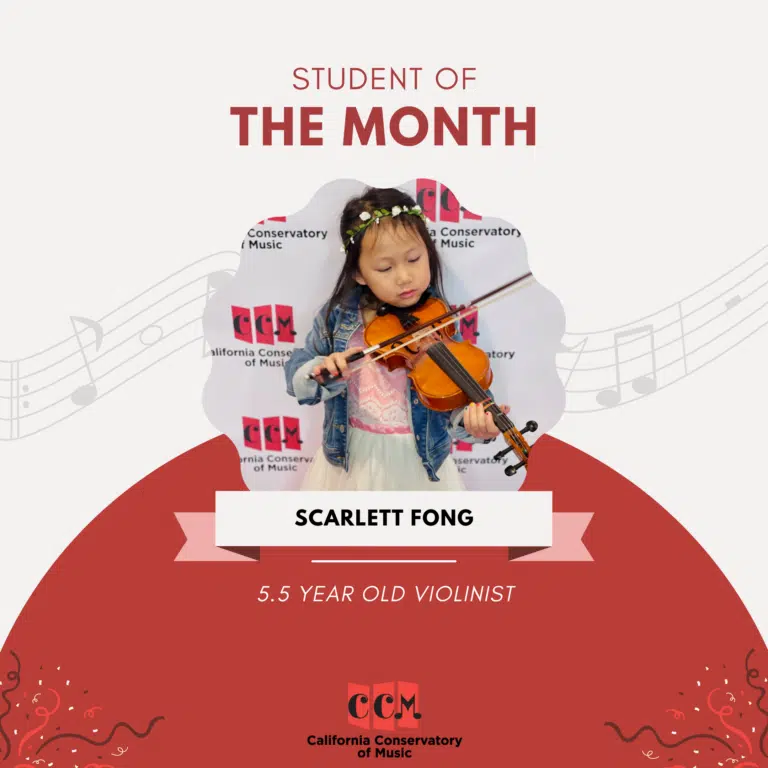
This April, we’re excited to feature CCM violin student, Scarlett Fong, as our Student of the Month! Scarlett has been taking violin lessons at CCM for just over a year. She currently studies at CCM’s Redwood City location with Teacher Emily. Scarlett has a natural gift of musicality and she’s always working hard to do her best in the lessons!
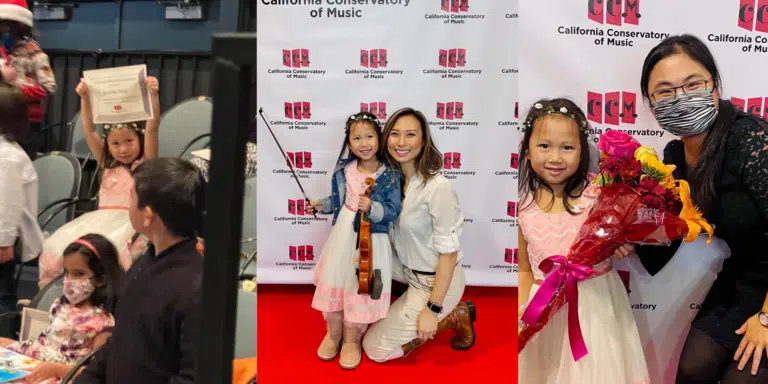
Student of the Month – Scarlett Fong
What is your name?
Scarlett Emerson Fong
How old are you?
5 1/2
Who is your teacher?
Ms. Emily
How long have you been taking violin lessons?
Since I was 4 years old. 1 year.
What advice would you give to a violin student just starting out at CCM?
That you can do it. Believe in yourself.
What piece are you looking forward to learning someday?
Something beautiful
What is your favorite thing about playing violin?
Performing for people.
What is your favorite food?
Pasta.
Do you have a pet?
No.
Do you play any sports or do any other activities outside of music lessons?
Ballet. Mandarin lessons. Tennis.
What do you want to be when you grow up?
A scientist and a violinist.
What is your most memorable experience at CCM?
My recital last year when I played dancing partners with Ms. Emily on stage.
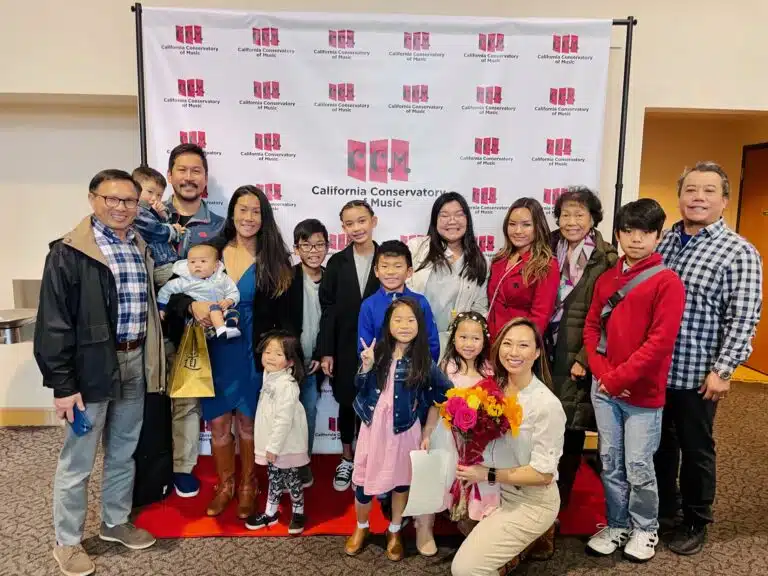
Parent Spotlight – Tiffany Fong
Regarding violin instruction, what are you most proud of your child accomplishing?
Violin has a very steep learning curve. The mental and tactile skills required are very challenging, and at times, can be very discouraging. She actually asked for a violin a few Christmases ago and was excited to play, but after starting and trying to learn, she wanted to quit. It was very hard. I’m most proud that she continues to persist even though it continues to challenge her. I am most proud that she tries to find the joy and fun in performing and doing it despite the many tears and frustration she has learning new things.
What advice would you give a new parent starting in the program?
It’s difficult to find the balance between pushing your child and letting them discover their passion on their own. I’ve framed violin as a responsibility that while not always fun, we must do to better ourselves. As is all things with our children, I am learning to be a better parent and guide too. There are important lessons in persistence, but also times when we can listen and give our child breaks or passes.
Why did you decide to give your child a musical upbringing?
She actually asked to play violin because I used to play. I had planned to put her in lessons later, but figured she was ready if she was interested. I think music is a really beautiful and personal avenue of expression. It’s a gift when parents provide those lessons and open doors for those skills. I’ve never met an adult who regrets knowing how to play an instrument or sing.
Gioachino Rossini: April Composer of the Month

Gioachino Rossini is one of the most renowned Italian composers of the 19th century. His work influenced opera tremendously and he is considered to be one of the greatest composers of the bel canto era. Rossini’s melodic beauty, dramatic intensity, and sparkling wit are notable aspects of his music.
Early Life
Gioachino Rossini was born on February 29, 1792, in Pesaro, Italy. Rossini grew up surrounded by music. His father, Giuseppe Rossini, was a horn player and his mother, Anna Guidarini, was a singer. It was clear that Rossini possessed musical talents at an early age, and he began studying with his father and other local musicians. By the age of 12, Rossini was already composing music as well as playing the piano and violin.
In 1806, Rossini was accepted into the prestigious Liceo Musicale in Bologna. There, he studied with the composer and musicologist Padre Stanislao Mattei. He was a strict instructor who emphasized the study of counterpoint. Rossini learned valuable skills from Mattei, but he was still eager to explore new musical styles and techniques.
Early Works
Rossini’s composed his first opera, La Cambiale di Matrimonio, when he was only 18 years old. The modest success of the opera encouraged him to continue composing. Over the next few years, Rossini wrote a series of comic operas that established his reputation. These included L’italiana in Algeri (1813), Il Turco in Italia (1814), and Il Barbiere di Siviglia (1816).
Il barbiere di Siviglia (The Barber of Seville) is arguably Rossini’s most famous opera. It is a comic masterpiece that follows the story of the wily Figaro, as he helps the young Count Almaviva win the heart of beautiful Rosina. The opera is full of memorable melodies, witty dialogue, and clever plot twists. The aria, “Largo al Factotum,” sung by Figaro, is one of the most universally famous and recognizable pieces of music to date.
Gioachino Rossini’s success with comic operas earned him the nickname, Il Signor Crescendo (Mr. Crescendo), because of his skillful use of crescendo in his music. He mastered the use of crescendo as he built tension and excitement in the music with the dynamics.
Later Works
In the 1820s, Rossini began to stray away from comic opera and move towards more serious works. He composed a series of tragic operas, including Otello (1816), La Donna del Lago (1819), and Semiramide (1823). While these operas were well-received, they did not achieve the same level of success as his comic operas.
By 1829, at the age of 37, Rossini retired from composing operas. He had achieved great success as a composer, but he was exhausted from the demands of the opera world.
Rossini moved to Paris in 1832, where he became a central figure in the city’s musical life. He composed a series of works for the Parisian stage, including the opera Guillaume Tell (William Tell), which premiered in 1829. Guillaume Tell was Rossini’s last opera and is considered by many to be his masterpiece. The opera tells the story of the Swiss folk hero William Tell, as he leads a rebellion against the Austrian oppressors. It features a number of well-known arias, including the famous overture, which is frequently heard in popular culture.
Rossini’s later works show a departure from the bel canto style of his earlier operas. He began to experiment with new forms and musical techniques, such as the use of the chorus and the integration of spoken dialogue. As he became interested in French opera, his later works showed the influence of French composers such as Gluck and Meyerbeer.
Legacy
Gioachino Rossini’s influence on the opera cannot be overstated. His comic operas are still performed today and continue to delight audiences with their wit and humor. His serious operas, while less well-known, are still admired for their dramatic power and musical sophistication.
In addition to his opera contributions, Rossini was also an important figure in the development of orchestral repertoire. He composed several overtures and other instrumental works that are still performed today. His overtures, in particular, are known for their lively rhythms and catchy melodies.
Rossini’s influence can be seen in the work of many later composers as well. His use of the crescendo, for example, was adopted by composers such as Wagner and Verdi. His tuneful melodies and lyrical style were also influential on composers such as Donizetti and Bellini.
Sign up for your free lesson at the California Conservatory of Music!
Approaching Music Education like Learning a Language
The processes of learning an instrument and a language are very similar. Both involve commitment, exposure, and consistency. One of the most significant similarities is that they both require frequent practice to become proficient. Approaching music education like learning a language can be an effective way to learn and develop musical skills.
Similarities Between Music and Language
One of the most obvious connections between music and language is that they both involve communication. In language, we communicate through speaking and writing, while in music, we communicate through sound. However, when you learn how to play an instrument, you are also learning how to read music, which is a language in and of itself! These forms of communication, both musical and linguistic, express emotion, convey ideas, and tell stories.
Both music and language require practice and repetition to become proficient. Learning a language involves listening, speaking, reading, and writing regularly to improve comprehension and fluency. Similarly, learning music involves practicing scales, chords, and techniques to improve performance and musicality. The Suzuki method is very effective because it takes advantage of these similarities. Suzuki students prioritize listening to the Suzuki repertoire and other music to familiarize themselves with their instrument.
Another fun similarity is that music and language both have their own unique grammar and structure. In language, we use syntax, grammar rules, and vocabulary to create sentences and convey meaning. In music, we use harmony, melody, and rhythm to create musical phrases and convey emotion.
Methods for Learning
When learning a language, there are several methods that can be used to improve fluency and comprehension. These methods can also be applied to learning an instrument for an effective education.
Immersion
Immersion involves being surrounded by the language. This looks like watching shows or listening to podcasts in the language you are learning, or traveling to another country. This method is also extremely helpful when applied to music education. For example, attending concerts, watching videos, and listening to music can immerse you in different styles and genres of music. This can help you to develop an ear for different sounds and rhythms, as well as an appreciation for the cultural significance of music.
Practice
One of the most, if not the most, important aspects of learning a language or instrument is regular practice. Regular practice is essential to developing one’s skills, such as physical technique, tone production, rhythm, and more. Setting aside time each day to practice scales, arpeggios, and songs can help you to improve your musical abilities over time. Not only does practice help with progress, it also will help build confidence!
Listening
When learning a language, it’s important to listen to native speakers to improve comprehension and pronunciation. Similarly, when learning music, it’s important to listen to professional musicians to develop an ear for tone, phrasing, and expression. Listening to music can also help you to develop a sense of style and genre, and assist you in finding out what you like!
Reading
Reading is another form of immersion, but it’s important enough to be its own method. With language, reading helps improve comprehension and vocabulary. Similarly, reading sheet music helps musicians improve their sight-reading skills, as well as their understanding of music theory and structure.
Applying Language Acquisition Strategies to Music Education
Build a Solid Foundation
When learning a language, it’s important to start with the basics, such as vocabulary, grammar, and pronunciation. Similarly, when learning an instrument, you must build a strong foundation and review scales, arpeggios, and chord progressions. These fundamentals provide the foundation for more advanced musical skills, such as improvisation and composition.
Imitate
Imitation is a common language acquisition strategy that involves mimicking native speakers to improve pronunciation and fluency. When learning an instrument, you’ll improve by imitating other musicians, or their teachers. This involves listening to recordings, watching videos, and attending concerts. By imitating their phrasing, dynamics, and expression, musicians can learn to play with greater musicality and emotion.
Develop a Music Vocabulary
Just as language learners need to develop a vocabulary of words and phrases, musicians need to develop a musical vocabulary of scales, chords, and tempo markings, and more. It’s important to learn and understand these terms early on so that you can continue to make steady technical progress.
Practice Regularly
Regular practice is essential. To make progress, musicians should set aside dedicated time each day to practice their instrument and work on improving their skills. This regular practice can help to develop muscle memory and improve technical proficiency, as well as build confidence and musicality. Practice sessions that are only 10-minutes are still more beneficial than none at all!
Get Feedback
Getting feedback on your performance can help you to identify areas for improvement and refine your technique and musicality. This feedback can come from teachers, peers, and parents, or even from recording and listening to your own performances.
Approaching music education like learning a language is an effective way to learn an instrument and enjoy doing it! Whether you’re a beginner or an experienced musician, applying these strategies can help you reach new levels of musical ability and creativity.
Sign up for your free lesson at the California Conservatory of Music!


